Abstract
Mice and rats were injected with tracer doses of radioactive N tau-[Me-14C]methylhistidine in order to determine the recovery of the injected radioactivity and the extent of the metabolism of N tau-methylhistidine. In the first 27 h after injection, 96.3, 78.0 and 97.5% of radioactivity was excreted by female mice, male mice and male rats respectively. Recovery after 5 days of collection was 98.4 and 92.8% for female and male mice respectively. However, radioactivity associated with N tau-methylhistidine or its acetylated derivative accounted for 44, 86.5 and 96.0% of the excreted radioactivity for female mice, male mice and rats respectively. In female mice the remaining excreted radioactivity was associated with four major peaks of activity when the metabolites were separated by cation-exchange chromatography. In male mice there were only three of these metabolites present. After chromatographic purification, one metabolite was identified by mass spectroscopy to be 1-methylimidazole-4-acetic acid. Examination of the possible sources of this metabolite indicates that, in mice, N tau-methylhistidine is decarboxylated and enters the chain of reactions common to histamine metabolism. Such extensive metabolism precludes the use of N tau-methylhistidine excretion as an index of myofibrillar protein breakdown in mice.
Full text
PDF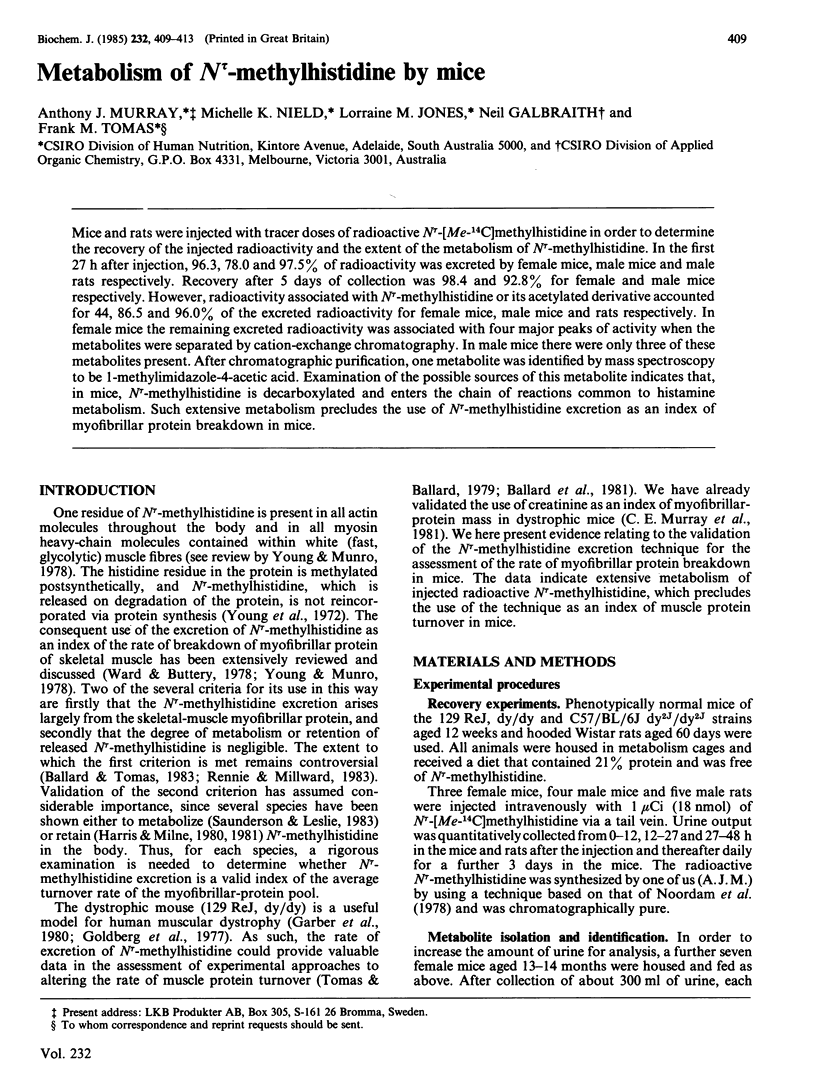
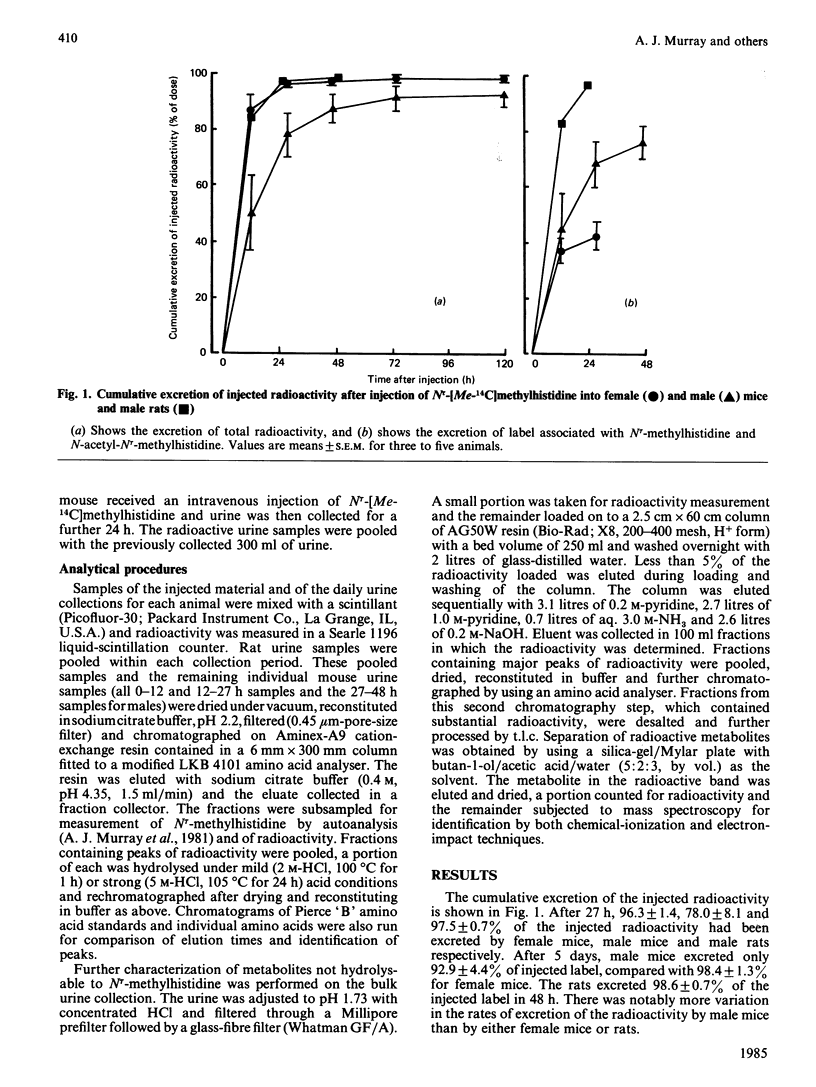
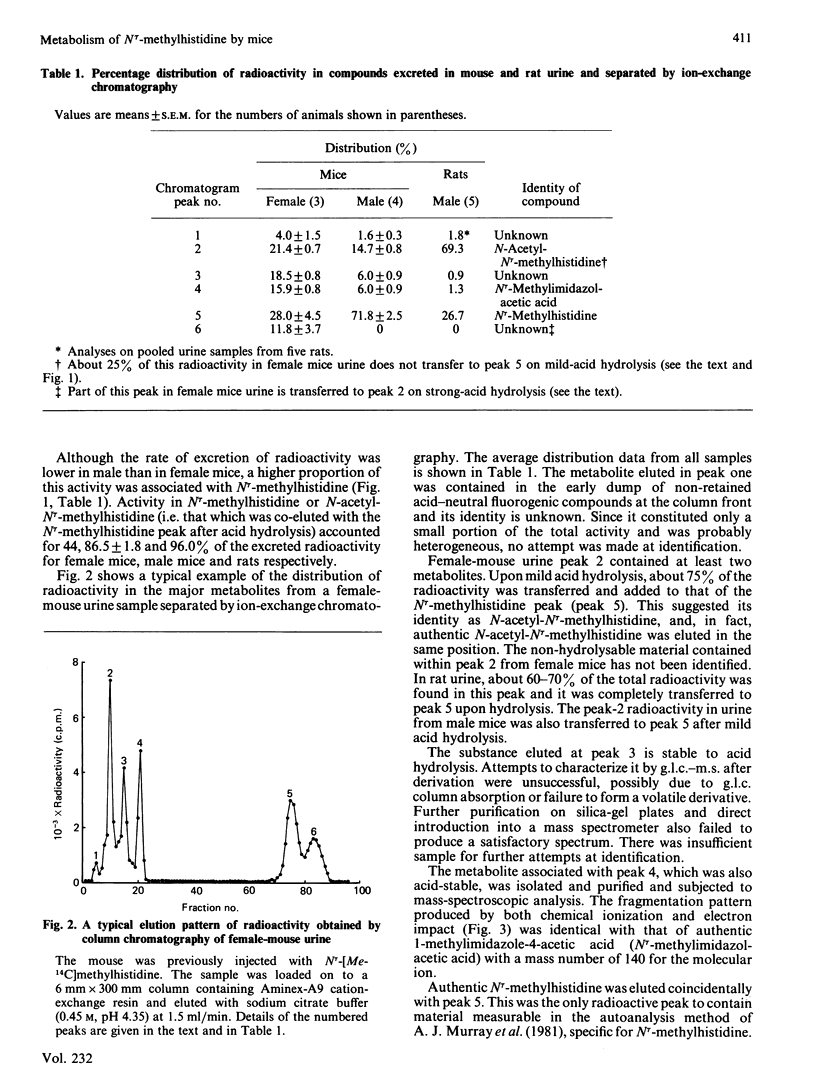
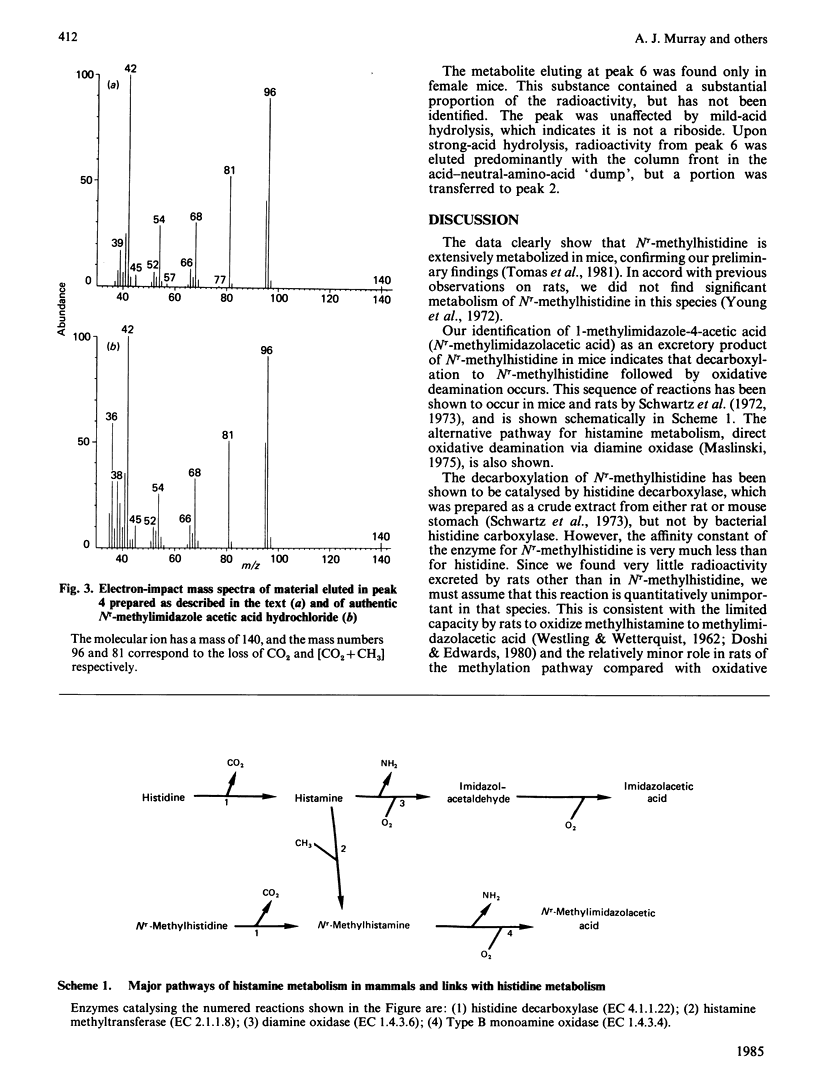
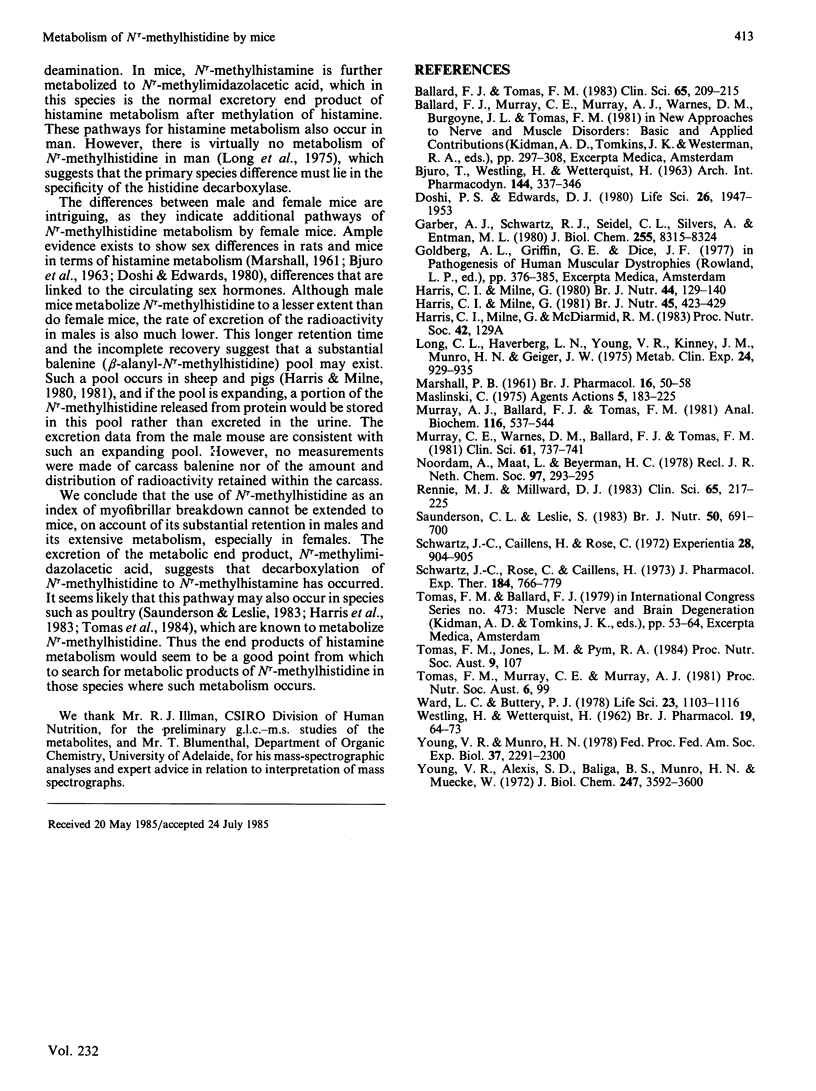
Selected References
These references are in PubMed. This may not be the complete list of references from this article.
- BJUROE T., WESTLING H., WETTERQVIST H. ON THE EVALUATION OF HISTAMINE FORMATION AND CATABOLISM IN RATS BY ANALYSIS OF THE URINE. Arch Int Pharmacodyn Ther. 1963 Aug 2;144:337–346. [PubMed] [Google Scholar]
- Ballard F. J., Tomas F. M. 3-Methylhistidine as a measure of skeletal muscle protein breakdown in human subjects: the case for its continued use. Clin Sci (Lond) 1983 Sep;65(3):209–215. doi: 10.1042/cs0650209. [DOI] [PubMed] [Google Scholar]
- Doshi P. S., Edwards D. J. Determination of urinary methylhistamine excretion in male and female rats by gas chromatography with electron-capture detection. Life Sci. 1980 Jun 9;26(23):1947–1953. doi: 10.1016/0024-3205(80)90625-6. [DOI] [PubMed] [Google Scholar]
- Garber A. J., Schwartz R. J., Seidel C. L., Silvers A., Entman M. L. Skeletal muscle protein and amino acid metabolism in hereditary mouse muscular dystrophy. Accelerated protein turnover and increased alanine and glutamine formation and release. J Biol Chem. 1980 Sep 10;255(17):8315–8324. [PubMed] [Google Scholar]
- Harris C. I., Milne G. The inadequacy of urinary N tau-methyl histidine excretion in the pig as a measure of muscle protein breakdown. Br J Nutr. 1981 Mar;45(2):423–429. doi: 10.1079/bjn19810117. [DOI] [PubMed] [Google Scholar]
- Harris C. I., Milne G. The urinary excretion of N tau-methyl histidine in sheep: an invalid index of muscle protein breakdown. Br J Nutr. 1980 Sep;44(2):129–140. doi: 10.1079/bjn19800020. [DOI] [PubMed] [Google Scholar]
- Long C. L., Haverberg L. N., Young V. R., Kinney J. M., Munro H. N., Geiger J. W. Metabolism of 3-methylhistidine in man. Metabolism. 1975 Aug;24(8):929–935. doi: 10.1016/0026-0495(75)90084-0. [DOI] [PubMed] [Google Scholar]
- MARSHALL P. B. Effect of sex hormones on the excretion of free histamine by male and female rats. Br J Pharmacol Chemother. 1961 Feb;16:50–58. doi: 10.1111/j.1476-5381.1961.tb00297.x. [DOI] [PMC free article] [PubMed] [Google Scholar]
- Maśliński C. Histamine and its metabolism in mammals. Part II: Catabolism of histamine and histamine liberation. Agents Actions. 1975 Aug;5(3):183–225. doi: 10.1007/BF02026434. [DOI] [PubMed] [Google Scholar]
- Murray A. J., Ballard F. J., Tomas F. M. A rapid method for the analysis of N tau-methylhistidine in human urine. Anal Biochem. 1981 Sep 15;116(2):537–544. doi: 10.1016/0003-2697(81)90399-7. [DOI] [PubMed] [Google Scholar]
- Murray C. E., Warnes D. M., Ballard F. J., Tomas F. M. Creatinine excretion as an index of myofibrillar protein mass in dystrophic mice. Clin Sci (Lond) 1981 Dec;61(6):737–741. doi: 10.1042/cs0610737. [DOI] [PubMed] [Google Scholar]
- Rennie M. J., Millward D. J. 3-Methylhistidine excretion and the urinary 3-methylhistidine/creatinine ratio are poor indicators of skeletal muscle protein breakdown. Clin Sci (Lond) 1983 Sep;65(3):217–225. doi: 10.1042/cs0650217. [DOI] [PubMed] [Google Scholar]
- Saunderson C. L., Leslie S. N tau-methyl histidine excretion by poultry: not all species excrete N tau-methyl histidine quantitatively. Br J Nutr. 1983 Nov;50(3):691–700. doi: 10.1079/bjn19830141. [DOI] [PubMed] [Google Scholar]
- Schwartz J. C., Caillens H., Rose C. An alternative route for biosynthesis of methylhistamine: in vitro and in vivo formation through decarboxylation of L-3-methylhistidine. Experientia. 1972 Aug 15;28(8):904–905. doi: 10.1007/BF01924935. [DOI] [PubMed] [Google Scholar]
- Schwartz J. C., Rose C., Caillens H. Metabolism of methylhistamine formed through a new pathway: decarboxylation of L-3-methylhistidine. J Pharmacol Exp Ther. 1973 Mar;184(3):766–779. [PubMed] [Google Scholar]
- WESTLING H., WETTERQVIST H. Further observations on the difference in the metabolism of histamine in male and female rats. Br J Pharmacol Chemother. 1962 Aug;19:64–73. doi: 10.1111/j.1476-5381.1962.tb01427.x. [DOI] [PMC free article] [PubMed] [Google Scholar]
- Ward L. C., Buttery P. J. Ntau-Methylhistidine--an index of the true rate of myofibrillar degradation? An appraisal. Life Sci. 1978 Sep 18;23(11):1103–1115. doi: 10.1016/0024-3205(78)90344-2. [DOI] [PubMed] [Google Scholar]
- Weekes T. E. The hormonal control of fat metabolism in animals. Proc Nutr Soc. 1983 Jun;42(2):129–136. doi: 10.1079/pns19830019. [DOI] [PubMed] [Google Scholar]
- Young V. R., Alexis S. D., Baliga B. S., Munro H. N., Muecke W. Metabolism of administered 3-methylhistidine. Lack of muscle transfer ribonucleic acid charging and quantitative excretion as 3-methylhistidine and its N-acetyl derivative. J Biol Chem. 1972 Jun 10;247(11):3592–3600. [PubMed] [Google Scholar]
- Young V. R., Munro H. N. Ntau-methylhistidine (3-methylhistidine) and muscle protein turnover: an overview. Fed Proc. 1978 Jul;37(9):2291–2300. [PubMed] [Google Scholar]


